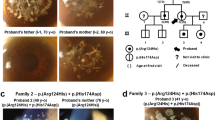Abstract
Gelatinous drop-like corneal dystrophy (GDLD; OMIM 204870) is an autosomal recessive disorder characterized by severe corneal amyloidosis leading to blindness1,2,3,4, with an incidence of 1 in 300,000 in Japan5. Our previous genetic linkage study localized the gene responsible to a 2.6-cM interval on chromosome 1p (ref. 6). Clinical manifestations, which appear in the first decade of life, include blurred vision, photophobia and foreign-body sensation. By the third decade, raised, yellowish-grey, gelatinous masses severely impair visual acuity, and lamellar keratoplasty is required for most patients5. Here we report DNA sequencing, cDNA cloning and mutational analyses of four deleterious mutations (Q118X, 632delA, Q207X and S170X) in M1S1 (formerly TROP2 and GA733-1), encoding a gastrointestinal tumour-associated antigen. The Q118X mutation was the most common alteration in the GDLD patients examined, accounting for 33 of 40 (82.5%) disease alleles in our panel of families. Protein expression anaysis revealed aggregation of the mutated, truncated protein in the perinuclear region, whereas the normal protein was distributed diffusely in the cytoplasm with a homogenous or fine granular pattern. Our successful identification of the gene that is defective in GDLD should facilitate genetic diagnosis and potentially treatment of the disease, and enhance general understanding of the mechanisms of amyloidosis.
This is a preview of subscription content, access via your institution
Access options
Subscribe to this journal
Receive 12 print issues and online access
$209.00 per year
only $17.42 per issue
Buy this article
- Purchase on Springer Link
- Instant access to full article PDF
Prices may be subject to local taxes which are calculated during checkout





Similar content being viewed by others
References
Nakaizumi, G. A rare case of corneal dystrophy. Acta Soc. Ophthalmol. Jpn 18, 949–950 (1914).
Mondino, B.J., Rabb, M.F., Sugar, J., Sundar Raj, C.V. & Brown, S.I. Primary familial amyloidosis of the cornea. Am. J. Ophthalmol. 92, 732–736 (1981).
Weber, F.L. & Bable, J. Gelatinous drop-like dystrophy: a form of primary corneal amyloidosis. Arch. Ophthalmol. 98, 144–148 (1980).
Smolin, G. Corneal dystrophies and degenerations. in Cornea (eds Smolin, G. & Thoft, R.) 499–533 (Little, Brown Company, Boston, 1994).
Santo, R.M., Yamaguchi, T., Kanai, A., Okisaka, S. & Nakajima, A. Clinical and histopathologic features of corneal dystrophies in Japan. Ophthalmology 102, 557–567 (1995).
Tsujikawa, M. et al. Homozygosity mapping of a gene responsible for gelatinous drop-like corneal dystrophy (GDLD) to chromosome 1p. Am. J. Hum. Genet. 63, 1073–1077 (1998).
Linnenbach, A.J. et al. Sequence investigation of the major gastrointestinal tumor-associated antigen gene family, GA733. Proc. Natl Acad. Sci. USA 86, 27–31 (1989).
Miotti, S. et al. Characterization of human ovarian carcinoma-associated antigens defined by novel monoclonal antibodies with tumor-restricted specificity. Int. J. Cancer 39, 297–303(1987).
Stein, R., Basu, A., Chen, S., Shih, L.B. & Goldenberg, D.M. Specificity and properties of MAb RS7-3G11 and the antigen defined by this pancarcinoma monoclonal antibody. Int. J. Cancer 55, 938–946 (1993).
Malthiery, Y. & Lissitzky, S. Primary structure of human thyroglobulin deduced from the sequence of its 8448-base complementary DNA. Eur. J. Biochem. 165, 491–498 (1987).
Kiefer, M.C., Masiarz, F.R., Bauer, D.M. & Zapf, J. Identification and molecular cloning of two new 30-kDa insulin-like growth factor binding proteins isolated from adult human serum. J. Biol. Chem. 266, 9043–9049 (1991).
El-Sewedy, T., Fornaro, M. & Alberti, S. Cloning of the murine TROP2 gene: conservation of a PIP2-binding sequence in the cytoplasmic domain of TROP2. Int. J. Cancer 75, 324–330 (1998).
Yu, F.X., Sun, H.Q., Janmey, P.A. & Yin, H.L. Identification of a polyphosphoinositide-binding sequence in an actin monomer-binding domain of gelsolin. J. Biol. Chem. 267, 14616–14621 (1992).
Pitcher, J.A. et al. Phosphatidylinositol 4,5-bisphosphate (PIP2)-enhanced G protein-coupled receptor kinase (GRK) activity. Location, structure, and regulation of the PIP2 binding site distinguishes the GRK subfamilies. J. Biol. Chem. 271, 249073–24913 (1996).
Lambrechts, A. et al. The mammalian profilin isoforms display complementary affinities for PIP2 and proline-rich sequences. EMBO J. 16, 484–494 (1997).
Basu, A., Goldenberg, D.M. & Stein, R. The epithelial/carcinoma antigen EGP-1, recognized by monoclonal antibody RS7-3G11, is phosphorylated on serine 303. Int. J. Cancer 62, 472–479 (1995).
de la Chapelle, A., Kere, J., Sack, G.H., Tolvanen, R. & Maury, C.P. Familial amyloidosis, Finnish type: G654–a mutation of the gelsolin gene in Finnish families and an unrelated American family. Genomics 13, 898–901 (1992).
Haltia, M. et al. Gelsolin gene mutation—at codon 187—in familial amyloidosis, Finnish: DNA-diagnostic assay. Am. J. Med. Genet. 42, 357–359 (1992).
Munier, F.L. et al. Kerato-epithelin mutations in four 5q31-linked corneal dystrophies. Nature Genet. 15, 247–251 (1997).
Kawasaki, K. et al. One-megabase sequence analysis of the human immunoglobulin λ gene locus. Genome Res. 7, 250–261 (1997).
Acknowledgements
This work was supported by a Research on Human Genome and Gene Therapy grant from Ministry of Health and Welfare of Japan.
Author information
Authors and Affiliations
Corresponding author
Rights and permissions
About this article
Cite this article
Tsujikawa, M., Kurahashi, H., Tanaka, T. et al. Identification of the gene responsible for gelatinous drop-like corneal dystrophy. Nat Genet 21, 420–423 (1999). https://doi.org/10.1038/7759
Received:
Accepted:
Issue Date:
DOI: https://doi.org/10.1038/7759
This article is cited by
-
TACSTD2 upregulation is an early reaction to lung infection
Scientific Reports (2022)
-
Corneal dystrophies
Nature Reviews Disease Primers (2020)
-
A novel mutation in gelatinous drop-like corneal dystrophy and functional analysis
Human Genome Variation (2019)
-
Amphioxus SYCP1: a case of retrogene replacement and co-option of regulatory elements adjacent to the ParaHox cluster
Development Genes and Evolution (2018)
-
Novel TACSTD2 mutation in gelatinous drop-like corneal dystrophy
Human Genome Variation (2015)



